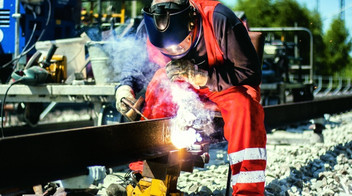Punctuality
Development in the year under review
Punctuality / % | 2023 | 2022 | 2021 |
DB Group (rail) in Germany | 90.1 | 90.9 | 93.7 |
DB rail passenger transport in Germany | 90.3 | 91.0 | 93.8 |
DB Long-Distance | 64.0 | 65.2 | 75.2 |
DB Regional | 91.0 | 91.8 | 94.3 |
DB Cargo (Germany) | 70.5 | 66.1 | 69.8 |
DB Regional (bus) | 85.2 | 86.0 | 83.9 |
DB Cargo | 69.7 | 66.3 | 69.5 |
Punctuality (whole journey) (DB Long-Distance) | 68.9 | 69.3 | 76.8 |
To measure punctuality, we compare the target arrival time to the actual arrival time for every train/bus run. We summarize the arrival of trains/buses on schedule or up to a defined maximum delay in the punctuality rate.
2023 was a year of major challenges in terms of the quality and punctuality of rail transport in Germany. Despite great efforts on the part of rail transport and rail infrastructure companies, punctuality in rail passenger transport has declined further. The reasons for this development were:
- Poor condition of facilities: The track infrastructure (e.g. switches, tracks) is outdated and prone to failure, mainly due to a backlog of investment in many areas of the network. This leads to a multitude of infrastructure constraints, which in turn cause train delays. In addition, the program launched already in mid-2022 to inspect and replace damaged concrete ties also resulted in considerable restrictions in 2023. Due to the extensive scale of the work, many low-speed sections had to be set up for long periods of time.
- Intensive construction activity and unstable construction planning processes: High capital expenditures on the rail network are essential for greater stability and reliability throughout the network. For this reason, a very high construction volume was once again realized in 2023. This affected the highly frequented bottleneck network (including the Riedbahn, the Kassel — Fulda high-speed line, the Cologne — Duisburg line and the Stuttgart hub), where restrictions have a particularly high negative impact on the quality of service. Besides the generally high level of scheduled construction volume, short-notice construction projects proved to be an additional burden in 2023.
- High network utilization: About 25% of all trains run through highly utilized sections of track, which are already highly utilized even without construction work because of the high volume of traffic. Moreover, individual transport hubs that have a major influence on the overall network, such as Frankfurt am Main, Cologne or Stuttgart, are operating at high capacity due to a sustained increase in traffic density, particularly at local transport level. Even minor disruptions in operational processes can have a major impact on the quality of operations throughout the network.
- Lack of robustness in the system: The current operational challenges across all production processes are leading to an increase in non-scheduled train services. If other disruptive factors affect operations, the lack of resilience will also lead to more severe and longer-lasting effects on operational quality.
- Tense personnel situation: Furthermore, in 2023, staff shortages in key operationally critical functions coupled with construction work and multiple strikes resulted in a high scheduling workload at the control centers, which in turn had a negative impact on the quality of operations.
Significant measures for improvement
In 2023, DB Group initiated and implemented a large number of measures to improve and/or stabilize the quality of operations. These measures often only take effect in the medium to long term. In addition, the impact of measures that have already been implemented is partially overcompensated by the negative structural effects.
Stabilization of rail operations and improved construction with SB²
We launched the SB² initiative in 2023 with the aim of stabilizing rail transport operations again. Over the next few years, we will need to carry out modernization and construction work at an even higher level than before in order to become more efficient and punctual again. However, this will require fundamental process changes and improvements.
The core approach in this regard is to implement a new rationale for mandatory and pre-scheduled construction periods for maintenance and capital expenditures, known as the container approach. Its key component is the creation of standardized construction times for maintenance (maintenance containers) and investment construction (investment containers), which makes it easier to schedule and utilize construction times. By earmarking construction times in the schedule over the long term, TOCs can be informed of any changes well in advance and communicate them to their customers.
We want to improve the condition of facilities through coordinated capital expenditures and then maintain this via predefined maintenance intervals using maintenance containers. The container types developed will ensure reliable availability of infrastructure followed by construction-free periods of several years.
Continuously scheduled maintenance prevents disruptions as it enables us to keep a closer eye on the condition of our facilities. Investment activities can be planned at an early stage and with the necessary capacity, also for our partners in the construction industry. Container logic for maintenance is scheduled to start in the second half of 2024. The introduction of the investment containers will be ramped up by the 2027 schedule year, as longer lead times will be required on account of the application deadlines for major construction projects. The measures required for this were defined in 2023 and a functional, cross-departmental program structure was created.
Strong quality management
Despite substantial efforts and capital expenditure programs, the quality of our products reached an all-time low in 2023. Not only is this reflected in the dissatisfaction of passengers and the high level of strain on our employees, it also jeopardizes the implementation of our growth strategy.
In our “Strong Quality Management for DB” project, we are focusing on prioritized core processes and are systematically improving them. We are working closely with those responsible for the processes on-site, uncovering weak points and defining effective decision-making and escalation points. Together with the business units and service units of DB Group, we have selected the top processes whose structural changes will enable us to achieve positive effects in the short and medium term and contribute to a sustainable increase in quality from our customers’ perspective.
By establishing additional quality assurance tools and standards, we are able to create transparency and measurability. For example, in the switch renewal process, we were able to identify and counteract the causes of capacity bottlenecks in the preparation of construction documents. In future, additional work will be minimized by reusing existing switch sketches for identical switches in the case of 1:1 replacements.
Steering the vehicle maintenance process at an early stage ensures the availability of materials and personnel when planning and carrying out (initial) inspections. This helps concretely to prevent short-term train cancellations in particular.
To improve our process quality, we are creating the basis for end-to-end digital workflows and comprehensive standards.
Operational stabilization at DB Long-Distance through improved personnel perocesses
We have optimized the following HR processes, among others, in order to stabilize operations at DB Long-Distance over the long term:
- Increase in train on-call personnel available: At busy railway hubs and locations prone to delays, additional on-call train personnel are included in the planning.
- Single-route deployment of personnel: To further curb the spillover effects of delayed employees, train personnel are increasingly being rostered only on individual routes and axes. For the traction unit drivers, shift planning is carried out in an isolated manner, taking into account a line bundle of train services with similar routes. For train attendants, the planning process takes single-
route travel into account. - Reliable personnel handovers: To avoid the risk of delayed personnel handovers and therefore a delay on one train being carried over to another, the buffer times in the train crew’s shifts have been extended. In addition, a buffer for external night’s rest for train attendants and on-board caterers has been included in the shift planning by increasing the minimum overnight period. The aim of this measure is to ensure compliance with statutory and collectively agreed rest periods without transferring delays to trains departing the following day, even in the event of delays of up to one hour. Since the measure was fully implemented in mid-2023, the number of personnel-related delays has been reduced for train attendants and on-board catering staff as well as for traction unit drivers.


